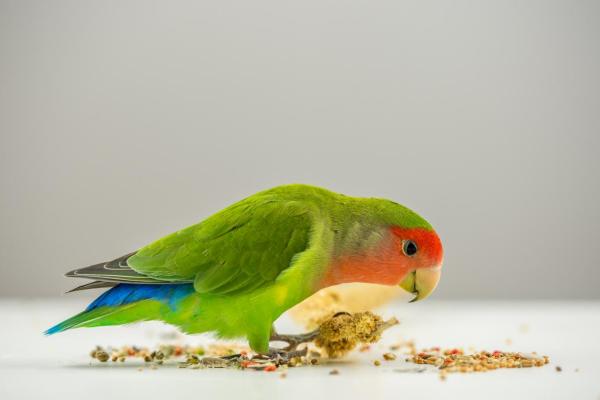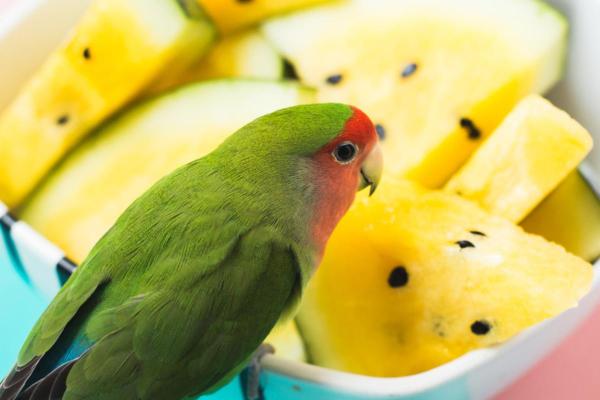
A Lovebird is a species of psittaciformes bird belonging to the Psittaculidae family that was introduced to Europe during the early nineteenth century. Lovebirds are a popular choice as a companion animal. They are small, delicate, easy to care for and have a life expectancy of 15 years. Lovebirds are granivorous, which means their diet is based on seeds or grains. However, there are many other things we can include in their diet such as fruits, vegetables, and even foods of animal origin. To meet the nutritional and behavioral needs of your lovebirds, we must provide them with a varied and balanced diet.
In this AnimalWised article, we will explain what lovebirds eat, so you can keep them as healthy and strong as possible.
Nutritional needs of lovebirds
Most people go to the pet store and buy a bag of birdseed for their birds because it is easy, cheap, and convenient. Although it is true that birdseed constitutes a healthy base for their diet, your lovebirds will get bored by eating the same thing every day. Moreover, a parrot that eats a balanced diet tends to be more active and has better plumage than one that eats an unbalanced diet.
The first thing you should take into consideration when owning a pet bird, is that you should try your best to recreate their natural habitat and routines. This way, you will keep the birds stimulated both physically and mentally. In the wild, lovebirds feed on all kinds of food, and it is very unlikely that they will eat the same thing every day. As with all other animals, birds need a balance of carbohydrates, proteins, fats, vitamins, minerals, and water.
Since you now know why a balanced diet is essential to your lovebird, it is crucial for you to know the proportions of these foods. Ideally, lovebirds and other small parrots should eat:
- 40% feed: feed for lovebirds should have around 15% protein, 8% fat and 3% fiber. The ideal amount is one or one and a half tablespoons of seeds per day.
- 30% of fruits and vegetables: they are a source of fiber, vitamins, and minerals. Keep in mind though that vegetables that have more water content do not offer as much nutrition as others.
- 30% from other foods: such as legumes, pasta, rice, sprouts and animal protein.
We must bear in mind that these nutritional requirements can vary slightly depending on each individual. Their activity level, age and environmental conditions are all factors that should be taken into consideration when determining the proportion of their food. There are special pelleted foods available for birds with specific nutritional needs, such as those that are very young, stressed, injured, laying eggs or raising young. Talk to your veterinarian for more information.
To know more about this type of bird and how to train them, do not miss our article on tips to train a lovebird.
How to feed your lovebirds
The following are some general considerations you should keep in mind when feeding your lovebrids:
- Make sure they have enough water. Lovebird love drinking water, and also bathing in it. It is very important that you make sure to change their water bowls every day, even several times a day. To prevent your birds from drowning, always use shallow water bowls.
- Lovebirds are very active, foraging much of the time and flying long distances in their natural habitats. Since pets cannot carry out these behaviors, it is important to provide them with alternative strategies to maintain their high level of activity. Making food difficult to access can also keep your birds active. There are many toys on the market designed for this purpose, you can also make your own.
- The sooner you start to provide your lovebirds with a balanced diet, the better. It might take some time for older lovebirds to get used to eating fruits and vegetables, especially for those who have been used to eating a grain-based diet, but don't stop trying.
- Keep an eye on how much your birds are eating every day. When you are introducing new foods, you can expect they will like some things more than others. But if you notice that they are not eating as much as they did, you should contact your veterinary to rule out any health implications.
- In the event that there are more than one lovebird in the cage, separate dishes should be used for each bird to ensure those at the bottom of the pecking order have a chance to eat. As a result, there will be no fighting or pecking at mealtime.
- If too many seeds are left in the dish at the end of the day, it could suggest that too many seeds were originally offered. Try to adjust the quantity of seeds you give to your birds based on how many seeds are left. Do not give your lovebirds seed mix that smells dusty or old.
- Feed the lovebirds at the same time every day so they know when to expect food.
- Provide the lovebirds with a variety of fruits and vegetables and change them up as often as possible.
- Wash fruits and vegetables before giving them to the lovebirds.
- Their food and water dishes should be earthenware or porcelain as lovebirds will chew the plastic dishes and this can be lethal.
If you notice your lovebird has diarrhea, keep reading this article on my lovebird has diarrhea, causes and treatment.
What to feed your lovebirds
Next, we list the foods that lovebirds should consume, as well as how often you should administer each one:
- Pelleted feed: they are made from cereal grains, legume seeds, and oleaginous fruits. Each feed grain contains the appropriate proportion of nutrients that the bird needs, which is why it is advisable that they constitute the base of your bird's daily diet.
- Seed mixes: lovebirds' mixes usually include millet, hemp seed, linseed, sunflower, oats, etc. Despite their traditional use as bird feed, seed mixes have a major disadvantage over pelleted feed. Because they contain a mixture of seeds, birds often pick out their favorite ones and discard the rest, which can unbalance their diet and cause nutritional deficiencies. The choice is usually between millet and sunflower seeds. Because of this, it is best to feed the birds pelleted feed on a regular basis and provide them with seeds only occasionally. You can provide seed mixes to your lovebirds three times a week.
- Fruits: Fruit is generally loved by lovebirds, so you should have no problem incorporating it into their diet. Apples may be given to your lovebirds as long as you remove the seeds. You may also give them fresh bananas, citrus fruits, berries, mangoes, melons, grapes, kiwi, papaya, peach, plum, any kind of pear, and star fruits. You can give the lovebirds dried fruits as long as they do not contain sulfites. You can give fruits to your lovebirds daily.
- Vegetables: Your lovebird's health can be greatly benefited by a diet rich in vegetables. Make sure to include vegetables that are rich in vitamin C and carotene, such as carrots, peppers, tomatoes, cabbage, and broccoli. You can give vegetables to your lovebirds daily.
- Legumes: Legumes are also a great source of nutrients and proteins. The best legumes you can offer to your lovebirds are chickpeas, lentils, nuts, tofu, and peas. You can give sprouted seeds to your lovebirds three times a week.
- Legume Sprouts:It is highly recommended that you feed your lovebirds sprouts as part of their diet. However, it is very important to control the germination process of the seeds in order to avoid the appearance of fungi that could harm your bird. You can give legumes to your lovebirds once a week.
- Cooked pasta and rice: You can occasionally include whole wheat pasta and rice, but you should not do so very often. Ideally, you should do this once or twice a month.
- Animal protein: You can also include from time to time a boiled egg and some dairy such as fresh cheese without salt or natural yogurt. Once or twice a month should be adequate.
If you are curious to know if lovebirds are better off living on their own or in groups, keep reading this article on can lovebirds live on their own?

Foods forbidden to lovebirds
As we have seen so far, lovebirds can eat a variety of foods. Nevertheless, some foods must be excluded from their diet, as they can have a negative impact on the health of your birds. In general, you should avoid fast foods, sugar-sweetened beverages, greasy foods, salty foods, and any type of carbonated or caffeinated beverages. You should also avoid giving lovebirds any foods that contain preservatives or additives.
Almost all plant foods are safe for lovebirds, but there are some that can be harmful to their liver. Under no circumstances should you feed your lovebirds the following foods:
- Avocado
- Eggplant
- Parsley
- Lime
- Rhubarb
- Navy beans
- Chocolate
- Apple seeds
- Onions
- Garlic

If you want to read similar articles to What Do Lovebirds Eat?, we recommend you visit our Healthy diets category.
- McDonald D. (2006). Nutritional considerations . In Clinical avian medicine . Spix Publishing. Pp. 86-107.
- Soto, CJ, Bert, E. (2011). Principles of psittacine feeding . REDVET; 12 (11): 1-39